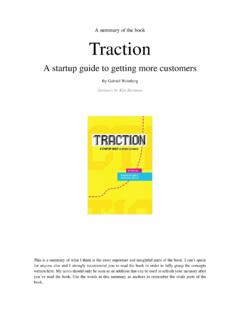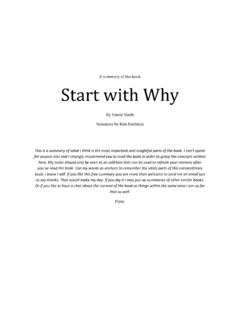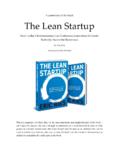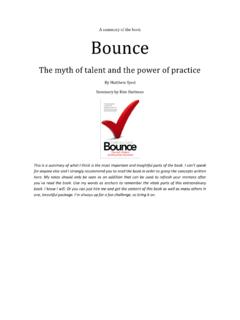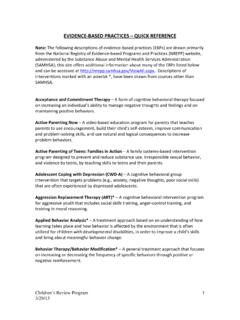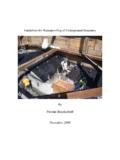Transcription of A summary of the book Save The Cat - Kim Hartman
1 A summary of the book Save The Cat The last book on screenwriting that you ll ever need By Blake Snyder summary by Kim Hartman This is a summary of what I think is the most important and insightful parts of the book. I can t speak for anyone else and I strongly recommend you to read the book in order to fully grasp the concepts written here. My notes should only be seen as an addition that can be used to refresh your memory after you ve read the book. Use the words in this summary as anchors to remember the vitals parts of the book. Contents Connect .. 3 Description from amazon .. 4 1. The Logline .. 5 2. Movie categories .. 6 a) Monster in the House .. 6 b) Golden Fleece .. 6 c) Out of the Bottle .. 7 d) Dude with a Problem.
2 7 e) Rites Of Passage .. 7 f) Buddy Love .. 8 g) Whydunit .. 8 h) The Fool Triumphant .. 9 i) Institutionalized .. 9 j) Superhero .. 9 3. Primal urge .. 11 4. Structure: The Blake Snyder Beat Sheet .. 12 Opening image (1) .. 12 Theme stated (5) .. 12 Set up (1-10) .. 13 Catalyst (12 .. 13 Debate (12-25).. 13 Break into two (25) .. 14 B story (30) .. 14 Fun and games (30-55) .. 14 Midpoint (55) .. 14 Bad guys close in (55-75) .. 15 All is lost (75) .. 15 Dark night of the soul (75-85) .. 15 Break into three (85) .. 15 Finale (85-110) .. 16 Final image (110) .. 16 1 5. Using cards and the board .. 17 First cards first .. 17 +/- AND > < .. 18 6. The immutable laws of screenplay physics .. 19 Diverse emotions .. 21 Character tonality.
3 21 7. More book summaries .. 22 2 Connect Get in touch! 3 Description from amazon This ultimate insider's guide reveals the secrets that none dare admit, told by a show biz veteran who's proven that you can sell your script if you can save the cat! 4 1. The Logline A catchy logline and a killer title will get you noticed. A well-structured screenplay will keep you in the game, and knowing how to fix your script and any other script you may be presented with will get you a career. The logline is your story's code, its DNA, the one constant that has to be true. A good logline, in addition to pulling you in, has to offer the promise of more.
4 It must satisfy four basic elements to be effective: 1. Irony. It must be in some way ironic and emotionally involving a dramatic situation that is like an itch you have to scratch. 2. A compelling mental picture. It must bloom in your mind when you hear it. A whole movie must be implied, often including a time frame. 3. Audience and cost. It must demarcate the tone, the target audience, and the sense of cost, so buyers will know if it can make a profit 4. A killer title. The one-two punch of a good logline must include a great title, one that "says what it is" and does so in a clever way. One of the key ingredients in a good title, however, is that it must be the headline of the story. Adjectives: In any good logline, there will always be a couple of adjectives involved: An adjective to describe the hero An adjective to describe the bad guy A compelling goal we identify with as human beings Has to have a lead character: It has to be about someone.
5 It has to have one or two main people we can focus our attention on, identify with, and want to root for and someone who can carry the movie's theme Hero in logline: Amping up a great logline with the hero who makes the idea work best is how the idea comes to life. And let's be clear, the trick is to create heroes who: > Offer the most conflict in that situation > Have the longest way to go emotionally > Are the most demographically pleasing. The logline tells the hero's story: Who he is, who he's up against, and what's at stake. The nice, neat form of a one- or two-sentence pitch tells you everything. Logline as checklist: The logline with the most conflict, the most sharply defined hero and bad guy, and the clearest, most primal goal is the winner.
6 And once you identify those characteristics and it works, stick to it. Use that logline to double-check your results as you begin to execute your screenplay. 5 2. Movie categories Movies are intricately made emotion machines. They are Swiss watches of precise gears and spinning wheels that make them tick. You have to be able to take them apart and put them back together again. It s the way we put new twists on old tales, bring them up to date, and give them a spin that's meaningful for our contemporaries. Genre: The reason categorizing your movie is a good idea is that it's important for you, the screenwriter, to know what type of movie you're writing. when you are stuck in your story or when you're preparing to write, you will "screen" a dozen movies that are like the one you're working on to get clues about why certain plot elements are important, why they work or don't, and where you can change the clich into something fresh.
7 10 types of movies: If you know what genre you're in, learn its rules and find what's essential. These categories are all you need for now to help you identify the story mechanics of the movie. The 10 types of movies are: a) Monster in the House Jaws, Tremors, Alien, The Exorcist, Fatal Attraction, and Panic Room It has two working parts: A monster. A house. And when you add people into that house, desperate to kill the monster, you've got a movie type so primal that it translates to everyone, everywhere The rules, to me, are simple. The "house" must be a confined space: a beach town, a spaceship, a futuristic Disneyland with dinosaurs, a family unit. There must be sin committed usually greed (monetary or carnal) prompting the creation of a supernatural monster that comes like an avenging angel to kill those who have committed that sin and spare those who realize what that sin is.
8 The rest is "run and hide." b) Golden Fleece Star Wars; The Wizard of Oz; Planes, Trains and Automobiles; Back To The Future; and most "heist movies." A hero goes "on the road" in search of one thing and winds up discovering something else himself. The milestones of The Golden Fleece are the people and incidents that our hero or heroes encounter along the way. Because it's episodic it seems to not be connected, but it must be. The theme of every Golden Fleece movie is internal growth; how the incidents affect the hero is, in fact, the plot. It is the way we know that we are truly making forward progress 6 it's not the mileage we're racking up that makes a good Golden Fleece, it's the way the hero changes as he goes.
9 And forcing those milestones to mean something to the hero is your job. Whatever fun set pieces our hero encounters must be shaded to deliver milestones of growth for our kid lead. It's not the incidents, it's what the hero learns about himself from those incidents that make the story work. This genre is also where all heist movies are found. Any quest, mission, or "treasure locked in a castle" that is to be approached by an individual or a group falls into the Golden Fleece category and has the same rules. Very often the mission becomes secondary to other, more personal, discoveries; c) Out of the Bottle Liar, Liar; Bruce Almighty; Love Potion ; Freaky Friday; Flubber "I wish I had a_" is probably the single most frequently spoken prayer since Adam.
10 And stories that tell a good "what if' tale that exploits these wish fulfillment fantasies are good, primal, easy-for-a-caveman-to-understand stories. The rules of Out of the Bottle then are this: If it's a wish-fulfillment tale, the hero must be a put-upon Cinderella who is so under the thumb of those around him that we are really rooting for anyone, or anything, to get him a little happiness. And yet, so the rules tell us and human nature dictates, we don't want to see anyone, even the most underdog character, succeed for too long. And eventually, the hero must learn that magic isn't everything, it's better to be just like us us members of the audience because in the end we know this will never happen to us.
